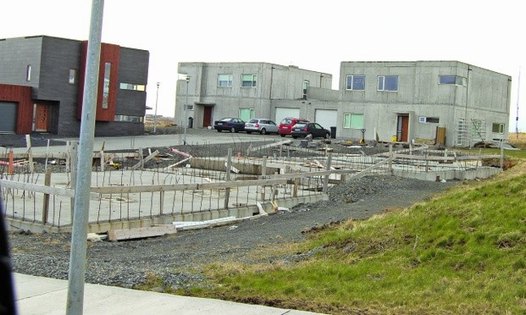
Partly finished buildings in Leirvogstunga, Mosfellsbær on the outskirts of Reykjavík Photo: Anna Karlsdóttir
The link between territory, the economy and politics is more bluntly visual on the outskirts of the city where the development of whole neighbourhoods has been put on hold after being planned during the housing boom in the middle of the last decade. The insatiable enthusiasm for construction affected the political behaviour of the municipalities in the capital region significantly, politicians and people alike, and generated heated internal competition over land bids thus significantly affecting prices. In the intersection between rural and urban here there exists a litany of failed projects.
One neighbourhood has already laid down streets but no more than one house has been built with only one family residing, in total, five inhabitants. Another neighbourhood has half of its population under 16 and no school, an apartment block only inhabited to 1/5 of its capacity. Unused building materials, a desert of gravel planned for something that was never to be. The examples of dashed dreams here are legion. Material possessions represent a trap rather than liberty because for many Icelanders who borrowed money during the housing boom devaluation meant that the real cost of these loans have skyrocketed.
The desire to have a place of your own can easily seduce the unwitting. Behind this are the geographies of despair and potential social problems. In many cases though, dilapidation is evident. For many of the entrepreneurs who took part in creating these new urban landscapes of speculation through construction difficulties have presented themselves in financing loans to complete what was started. Therefore many houses remain incomplete, neither weather, wind nor rain proof. They suffer in the meantime from the vandalism wrought both by the harsh elements and disillusioned people. Wasted opportunities, wasted values and materials, wasted landscapes and wasted lives.
The new millennium in Iceland was marked by the privatisation of the banks (Althingi, 2010). As in other market economies a whole new array of financial instruments (product innovation) appeared on the scene with increasing frequency, notably those providing new methods of lending and borrowing and those facilitating the greater spread of risk with the phenomenal growth of derivatives (Dickens, 2011). At the same time the regulatory walls crumbled – even collapsed altogether in some cases. This was a consequence of major deregulation as had occurred in all the major developed economies since the 1980s allowing banks to become involved in a whole new variety of financial services.
In Iceland as a result of deregulation the newly privatised banks were, from June 2004, able to enter the mortgage market where the housing financing fund (HFF) and pension funds had previously on the basis of existing legislation been the sole lenders for housing purposes. Not only did this change bring about easier access to loans and financial capital for house building but also raised the proportion of loans available in several currencies. Banks have now taken over some 2 200 pieces of real estate. However, according to well-informed sources the number in reality is closer to 16000. At the same time the planning authorities have admitted that over 7 000 apartments have been built above and beyond current needs.
The result is that many neighbourhoods currently in the midst of construction or newly constructed are half empty and are likely to remain so. Some buildings have been left empty; others are simply not for sale. Some are partly finished with families living in one corner of the building while the time perspective in terms of completion remains 'open-ended'. As both 'down at heel' entrepreneurs and private families have trouble refinancing loans in order to finish building work, properties are repossessed by the banks who are then accused of holding them hostage (what Americans term shadow inventory ownership). The market value has thus not decreased significantly as initially expected and thus rental apartments remain very expensive.
As with the Irish, the Icelandic population has always favoured privately owned properties. As an example, already in 1979 around 85% of the housing mass in Reykjavik was privately owned, a figure that rose to around 91% in neighbouring municipalities in the Capital region, making rental housing a fringe phenomenon (Icelandic property registry, 2005).
Social housing has never been the hallmark of Reykjavik. In some condominiums in Reykjavik there are however some social apartments (see picture below). The displaced population continues to look for temporary rental accommodation, but all such options are extremely expensive.
Though the Icelandic government has, since early 2009, outlined several plans to rescue hard hit property owners, the practice of the financial institutions has at times seemed to counteract what was intended, namely, to raise a security wall for indebted Icelandic families. At the current time of writing the future for home owners remains somewhat uncertain.
While the policy on privately-owned properties worked well during times of prosperity it does not function as well during economically difficult periods. The capital area of Reykjavik is faced with a situation where many former house and apartment owners will become tenants because their economic situation does not allow them anything else. It remains to be seen how the government and municipal authorities will deal with that situation.
Meanwhile a significant percentage of the new housing stock is facing vacancy and/or destruction. There is an ever larger contrast in Reykjavik, of glittering shopping centres and areas of despair. While the echo of the music from Harpa fuels hopes for a reformation the outskirts of the city are still evident monuments to blighted landscapes.
By Anna Karlsdóttir, Assistant professor, University of Iceland and Søren Bitsch, Economist & Geographer, University of Roskilde.
References
Althingi, the Icelandic Parliament. 2010. Report of the Special Investigation Commission. April 12th. 2010. http://sic.althingi.is/
Dicken, P. 2011. Global Shift: mapping the changing contours of the world economy. 6th Edition. London: Sage Icelandic Property registry/fasteignamat Ríkisins. 2006. Ársskýrsla 2005.